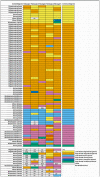Inter-pathologist agreement on diagnosis, classification and grading of canine glioma
- PMID: 35856268
- PMCID: PMC9795880
- DOI: 10.1111/vco.12853
Inter-pathologist agreement on diagnosis, classification and grading of canine glioma
Abstract
Histopathological evaluation of tumours is a subjective process, but studies of inter-pathologist agreement are uncommon in veterinary medicine. The Comparative Brain Tumour Consortium (CBTC) recently published diagnostic criteria for canine gliomas. Our objective was to assess the degree of inter-pathologist agreement on intracranial canine gliomas, utilising the CBTC diagnostic criteria in a cohort of eighty-five samples from dogs with an archival diagnosis of intracranial glioma. Five pathologists independently reviewed H&E and immunohistochemistry sections and provided a diagnosis and grade. Percentage agreement and kappa statistics were calculated to measure inter-pathologist agreement between pairs and amongst the entire group. A consensus diagnosis of glioma subtype and grade was achieved for 71/85 (84%) cases. For these cases, percentage agreement on combined diagnosis (subtype and grade), subtype only and grade only were 66%, 80% and 82%, respectively. Kappa statistics for the same were 0.466, 0.542 and 0.516, respectively. Kappa statistics for oligodendroglioma, astrocytoma and undefined glioma were 0.585, 0.566 and 0.280 and were 0.516 for both low-grade and high-grade tumours. Kappa statistics amongst pairs of pathologists for combined diagnosis varied from 0.352 to 0.839. 8 % of archival oligodendrogliomas and 61% of archival astrocytomas were reclassified as another entity after review. Inter-pathologist agreement utilising CBTC guidelines for canine glioma was moderate overall but varied from fair to almost perfect between pairs of pathologists. Agreement was similar for oligodendrogliomas and astrocytomas but lower for undefined gliomas. These results are similar to pathologist agreement in human glioma studies and with other tumour entities in veterinary medicine.
Keywords: brain; cancer; dog; histopathology; immunohistochemistry.
© 2022 The Authors. Veterinary and Comparative Oncology published by John Wiley & Sons Ltd.
Conflict of interest statement
The authors have no conflicts of interest to declare with regards to the work of this manuscript.
Figures

References
-
- Koestner ABT, Fatzer R, Schulman FY, Summers BA, Van Winkle TJ. Histological Classification of Tumors of the Nervous System of Domestic Animals. Armed Forces Institute of Pathology; 1999.
-
- Belluco S, Avallone G, Di Palma S, et al. Inter‐ and intraobserver agreement of canine and feline nervous system tumors. Vet Pathol. 2019;56:342‐349. - PubMed
MeSH terms
Grants and funding
LinkOut - more resources
Full Text Sources
Medical

